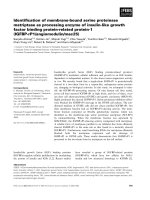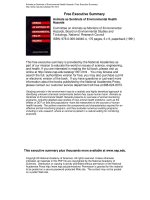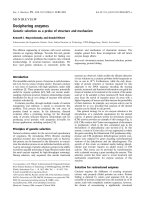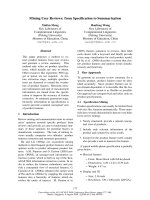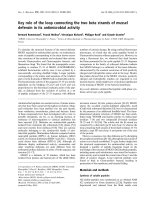Copper as key indicator of economic health
Bạn đang xem bản rút gọn của tài liệu. Xem và tải ngay bản đầy đủ của tài liệu tại đây (4.14 MB, 92 trang )
Copper
as
a
Key
Indicator
of
Economic
Health
Submitted
By
Deependra
Singh
Rao
Dissertation
Copper as a Key Indicator of Economic
Health.
Dissertation submitted in part fulfillment of the requirements
for the degree of
Masters of Business Administration in Finance
Dublin Business School
Submitted by
Deependra Singh Rao
Supervisor
Mr. Andrew Quinn
10233761
MBA (FINANCE)
2016
2
Declaration
I, Deependra Singh Rao, hereby declare that this dissertation is the result of my
own research hence every word so written is by me along with all details. All
the sources are attributed and cited to their authors. This dissertation is solely
meant for Masters of Business Administration in Finance and will not be a part
of any other academic award.
Signed: Deependra Singh Rao.
Dated: 23rd May 2016
3
Acknowledgement
The satisfaction and euphoria that accompany the successful completion of any
task would be incomplete without the mentioning of the people whose constant
guidance and encouragement made it possible. I take pleasure in presenting
before you, our project, which is result of studied blend of both research and
knowledge.
I express my earnest gratitude to my Dissertation Guide, Mr. Andrew Quinn, for
his constant support, encouragement and guidance. I am very grateful for his
cooperation and his valuable suggestions. It would not be possible to make this
dissertation without his cooperation
I express my gratitude to all the participants who contributed in this research
with their precious time and patience that is highly appreciated.
Finally I would like to thank my family specially my uncle for supporting me. It
is because of them that I learned the value of a human being.
4
Abstract
Copper is the oldest metal known to humans. It plays important role in old
civilizations like Egyptian and Romans. But the importance of copper is increased
after the industrial revolution and today it played an important role in global economy.
Even many market analysts see it as an indicator of economic health. Because of
that it gained the title of “Doctor” and it known as Doctor Copper in economics. But
from last few years market analyst thinks that it lost its Doctor title. Now it is not
effective indicator of economic growth.
The main aim of this research is to find Is copper still economic indicator or not. The
first part of this study will concentrate on whether copper is an economic indicator or
not and also find the reason behind why it is economic indicator. The second part of
this research aims on comparing copper with other metals and important commodity,
to understand why not other metals seen like an economic indicator.
The third part of this research will propose the research design, Implementation and
method of data collections. The final section of this study shows the outcome of
primary data that is collected by three in depth semi structured interviews with the
managers and trader who are working in copper industry. These interviews allowed
researcher to conclude the research.
5
Table of Contents
1. INTRODUCTION............................................................................................................. 10
1.1 Evolution of Copper.................................................................................................................. 10
1.2 Copper and Economy ............................................................................................................... 11
1.3 Purpose of Research. ................................................................................................................ 14
Objectives of the research............................................................................................................. 14
Research Question ........................................................................................................................ 14
1.4 Dissertation Roadmap .............................................................................................................. 15
1.5 The Scope of Research.............................................................................................................. 16
1.6 Reason behind choosing this topic........................................................................................... 16
2. Literature Review.............................................................................................................. 17
2.1 Copper’s Production & Usages................................................................................................ 17
2.1.1 Copper Production............................................................................................................... 17
2.1.2 Copper Usages..................................................................................................................... 23
2.2 Copper’s Economic Importance .............................................................................................. 28
2.3 Copper price and Economic trends......................................................................................... 33
2.4 Copper as Dr. Copper............................................................................................................... 36
2.5 Comparison of copper and other important commodities. ................................................... 37
2.5.1 Copper and Oil..................................................................................................................... 37
2.5.2 Copper And Iron ore............................................................................................................ 39
2.5.3. Copper and Aluminium ...................................................................................................... 41
2.5.4. Copper and nickel............................................................................................................... 42
2.6 Importance of copper in Modern Era..................................................................................... 44
3. Research Methodology...................................................................................................... 47
3.1 Proposed Methodology ............................................................................................................. 47
3.2 Research Design ........................................................................................................................ 47
3.2.1 Research Philosophy............................................................................................................ 48
3.2.2 Research Approach.............................................................................................................. 51
3.2.3 Research Strategy ................................................................................................................ 53
3.2.4 Research Choice .................................................................................................................. 54
3.2.5 Time Horizon....................................................................................................................... 55
3.2.6 Data Collection Method....................................................................................................... 56
3.2.7 Sampling.............................................................................................................................. 58
3.3 Research Ethics ......................................................................................................................... 59
3.4 Research Limitations ................................................................................................................ 60
6
4. Data Analysis And Finding .............................................................................................. 61
4.1 Introduction............................................................................................................................... 61
4.2 Methodology of research .......................................................................................................... 61
4.3 Participants Information.......................................................................................................... 62
4.4 Interviews................................................................................................................................... 63
5. Discussion & Conclusion .................................................................................................. 67
6. PERSONAL REFLECTION............................................................................................ 73
6.1 INTRODUCTION..................................................................................................................... 73
6.2 REFLECTION ON LEARNING BACKGROUND .............................................................. 74
6.3 DEVELOPMENT OF LEARNING AND PERFORMANCE .............................................. 75
6.4 PLANNING AND PREPARATION ....................................................................................... 77
6.5 PSYCHOLOGY ........................................................................................................................ 77
6.6 SCOPE OF FUTURE APPLICATION FOR LEARNING .................................................. 78
Bibliography .......................................................................................................................... 79
Appendix ................................................................................................................................ 86
7
List
of
Figures
Figure 1.1 Copper-relief found at Al'Ubaid, near Ur, dating from about 3100 B.C……………………...11
Figure 1.2 Dissertation Roadmap…………………………………………………………………………….15
Figure 2.1 Copper Producing Countries in the world.……………………………………………………...17
Figure 2.2 World Copper Mine Production………………………………………………………………….18
Figure 2.3 Copper Production according to Region from 1960 to 2014/15……………………………...20
Figure 2.4 Top 10 Countries in Copper Mine Production Worldwide From 2010-15.…………………..21
Figure 2.5 Consumption of Copper according to Country.………………….……………………………..22
Figure 2.6 World refined Copper Usage 1900- 2014………………….………………….………………..23
Figure 2.7 Refined Copper Usage by regions in 1960, 1980 & 2014………………….…………………24
Figure 2.8 Share of copper consumption by region………………….………………….…………………25
Figure 2.9 Share of copper usage by industries.………………….………………….…………………….25
Figure 2.10 Correlation between GDP growth and annual copper price change percentage…………31
Figure 2.11 Long Term Correlation between copper prices & economic indicators……………………32
Figure 2.12 China GDP and Copper price relation.………………….………………….…………………34
Figure 2.13 USA GDP growth rate and Copper price relation.………………….………………………..35
Figure 2.14 Average Copper Price from 2000 to 2015………………….………………….……………..36
Figure 2.15 Oil prices and world GDP Realtion………………….………………….……………………...38
Figure 2.16 Iron ore Prices and Global GDP relation………………….………………….……………….39
Figure 2.17 Aluminum and copper consumption and Global GDP………………….…………………....41
Figure 2.18 Copper and Nickel Consumption………………….………………….………………….…….42
Figure 2.19 Nickel Usages from 1990 to 2014………………….………………….………………….……43
Figure 3.1 Research onion by Saunders………………….………………….………………….………….48
Figure 6.1 The Experimental Learning Cycle, Kolb 2005………………….………………….………….74
Figure 6.2 Four stages mentioned by kolb………………………………………………………………….75
8
List
of
Table
Table 1: World Copper Production, 2011-15………………………………………………………………..19
Table 2: Correlation between Industrial Metals & Economic……………………………………………...30
Table 3: Copper business cycle………………………………………………………………………………31
9
CHAPTER
I
1. INTRODUCTION
“Technology”, a word of great importance in today’s world, isn’t it?
Over the years, technology has advanced to such an extent that it plays a vital role
from the basic level which involves an individual’s day to day activities such as
mobile phones, computers, television, household appliances and so on, to the
advanced technological levels such as cars, machines, satellites, etc.
We know that a basic requirement for any technology to operate is electricity. But,
here, a question arises as to which is the key element which causes electricity to
operate. The answer to this question is COPPER. The reason for which copper is
used, as it is the only metal which is a good conductor of heat and electricity, which
does not result in any adverse affect. Furthermore, copper cannot be replaced by
any other metal due to its unique characteristics.
Copper is widely used in our daily lives through the technologies we depend on,
which may be from television to a car, from a mobile phone to a laptop etc. Copper is
also widely used to supply electricity to nations across the globe through cable wires.
Therefore, we can say that copper is a basic element in our lives.
1.1 Evolution of Copper
Copper has played a vital role in the Human history. It has proven to be an important
metal to mankind since the ancient times. Copper consists of many alloys which
have also played a vital role in various civilizations, starting from the ancient
Egyptians to the present culture around the globe. Sumerians and Chaldeans of
Mesopotamia first utilized it around 5000 – 6000 years back. These groups of people
created impressive skills in manufacturing copper.
10
Fig. 1.1 Copper-relief found at Al'Ubaid, near Ur, dating from about 3100 B.C.
So over the period of time copper has been extracted and highly used by the
humans, but the production of copper has drastically changed during the Industrial
Revolution. In late 18th century around 230 tons of copper ore were extracted to
produce 18 tons of copper. As time flies and the technology develops the demand of
copper increases.
Today, copper is utilized as a part of assorted routes in numerous zones of life.
Copper is a phenomenal electrical conductor thus it is utilized as a part of electrical
wiring and gadgets. Copper is profoundly impervious to the harm of water and
different components, so it is every now and again utilized as a part of construction.
It is said that the measure of copper a country uses is a decent pointer of how
innovatively propelled the country is. In the 1800's America was importing more then
half of the copper it utilized. Today America is 100% independent, however the
interest for copper is developing. There is dependably a need to open new mines
and give this vital mineral to our future advancement.
1.2 Copper and Economy
Copper is a noteworthy segment of the economy and plays an especially vital part in
rising nations. . The copper industry is a critical benefactor to the overall economy.
Copper is more than just a mined metal. It is a supplier of occupations and a
promoter of a higher desire for ordinary life. It is an essential piece of our day-by-day
lives. One ton of copper bring 40 cars into function, powers 60,000 cellular
telephones, empowers operations in 400 laptops and PC's, and disseminates power
to 30 houses. The wide assortment of its applications, it is frequently proposed that
11
the patterns in the copper business sector are a helpful driving pointer of the
condition of the world economy.
Advancements on the world economy have a solid connection with developments in
the copper cost. Patterns in Chinese GDP development (and, to a lesser degree, US
and EU GDP development) and world exchange play a vital part. The connection
with China is the key variable in this setting. China represents the biggest share by a
wide margin of worldwide copper utilization (around 46%), furthermore has a big
share in the aggregate creation of immaculate copper (around 34%). Given these
figures, it is not really shocking that monetary advancements in China are firmly
fixing to the copper cost. The EU represents somewhere in the range of 18% of
worldwide copper utilization, and the US for around 8%. Subsequently, the
relationship with EU and US GDP development is marginally lower.
The connection between world exchange and copper value developments is too
solid. Given that generation and utilization of metals for the most part take place in
various parts of the world, worldwide exchange metals and refined metals (via area
or ocean) are unavoidable. At the point when the copper value falls, this might
indicate a fall sought after, and thusly a decrease in worldwide exchange dry mass
products (iron mineral, copper, aluminum, and so forth). In this sense, the copper
cost can serve as a pointer for world exchange volumes. Be that as it may, spikes in
the copper cost (as happened in mid 2006) might disturb the examples and make it
harder to survey world exchange volumes.
In financial market copper is mostly called by the name of Dr Copper because of its
PhD in Financial Aspects, which is because of its ability to foresee defining moments
in the worldwide economy. Demand for copper is frequently a solid driving pointer of
financial wellbeing. Increasing cost of the metal recommend development, on the
other hand decreasing cost may show the slow growth of economy. Copper has its
use in wide varieties of applications in many areas of the economy from households
and manufacturing plants to electronics appliances and power production &
transmission.
12
Here, we aren't simply speaking "Dr." as in "Health expert" conveying wellbeing and
imperativeness to the area, additionally utilizing the expression "Dr." to allude to an
informed "doctorate" or Ph.D. in financial matters. Consistently and over the whole
globe, one can viably see absolutely where we as a whole all in all, and a specific
nation is going financially, basically by observing the cost and what they are as of
now doing with copper. This implies whether you're discussing Big Construction
ventures, base recharging, modification in medical, telecommunication, technology,
energy etc. in this types of any event that it's occurring, then you will find Dr Copper
at the operations. Over the last century, simply the demand of refined copper has
expanded from 500,000 metric tons to more than 19 million metric tons. The
sensational ascent in requirement for copper will actually build the interest for new
mines and handling plants, as present offices are redesigned and extended. As
those "less created" areas start to extend their foundations, copper actually serves
as the most solid building obstruct" from which to manufacture another progress and
enhance normal expectations for everyday comforts. An impeccable case is the thing
that we have been seeing in the late Chinese development boom.
The major part of copper produce is consumed by the developing nations like China,
India. In this type of countries the demand of copper shows the rate of development
in the nation, and as the development continues people will get employments that
will directly affect on the economic growth of the nation. Demand of copper tells the
economic health of a nation. And as the demand increases price will also be
increased proportionally.
As we know copper is used in almost all type of industry, no other metal can replace
so the end consumers cannot substitute it as they can do for the other base metals.
As the time passes uses of copper increases, in the beginning it was only using for
the power transmission and supply but now days it has wide use of applications
which increase the demand of copper worldwide.
13
1.3 Purpose of Research.
The main aim of this research is to find the relation between the copper and the
global economic health. From very long period of time copper is seen as indicator of
economic health. But since last few years it is not doing well which divides the
market analyst into two parts. Many of them think that copper has looses its quality
of predicting economic health. After the completion of result it will be cleared whether
copper is an economic indicator or not in present scenario and will it be continue to
be an economic indicator in future.
This research will also compare copper with other important metals and commodity
and find out which metal is more effective in indicating economic health. In this
research, researcher will also explains which countries are more sensitive to copper.
It will also try to explain why copper is such an important commodity.
Objectives of the research
•
To find the relation between copper and economic growth/health.
•
Importance of copper.
•
Which countries are more sensitive to copper?
•
Compare copper with other metals and commodity.
Research Question
Primary Question
Is copper is still a leading key indicator of economic health?
Sub Questions
1. Is Copper (excluding oil) the world's most important commodity? YES/NO (Why)
2. What industries are particularly sensitive to Copper prices?
3. What countries (economies) are particularly sensitive to Copper prices
4. Has Dr. Copper been an effective leading indicator of world economic growth?
5. Will Dr. Copper continues to be a leading indicator of world economic growth?
6. Are production levels (demand) for Copper a better indicator than its price?
14
1.4 Dissertation Roadmap
This research will consist of Six Chapters Introduction, Literature Review, Research
Methodology, Data Analysis/Findings, Discussion and Conclusion along with
Personal Reflection. The first chapter is Introduction that will talk about the
background and history of the topic, research question, and future scope. The next
chapter is Literature Review it consists previous research conducted on the topic. It
also include theories, concept, models that are relevant to the topic.
Introduction
Literature
Review
Research
Methodology
Data
Analysis/Findings
Discussion
Conclusion
Fig. 1.2 Dissertation Roadmap
The Next two chapters consist of research methodology and Data Analysis/findings.
Research Methodology chapter describes the underlying assumptions about the
methodology of research. In this chapter researcher tried to explain the research
onion by Saunders, and what methods he used to make this dissertation. In data
analysis/ finding chapter data will be analyzed which is collected through case
studies, grounded theory and interviews. The fifth chapter i.e. Discussion will give
the answer of the research question and scope for future studies. The final Chapter
is Conclusion in which researcher make a final result on the basis of primary and
secondary research.
15
1.5 The Scope of Research.
In this research, researcher tries to include as much information as he can. As the
research is based on copper, it includes the role of copper in economy, its uses,
demand and supply game of copper, countries role in copper consumption,
comparison between copper and other important commodity like oil, iron.
This research will also give benefit to the future researcher who will try to find the
relation between copper and economic growth. It will provide a base for the future
findings.
1.6 Reasons for choosing this topic
As the researcher is from science background, hence technical aspects of recent
financial ups and downs grab his attention. As he did his bachelors in electronics and
communication he understand the value of copper in a humans life. In the recent
time all of sudden price of copper decreased that grab attention of researcher. So
after some initial studies researcher finds some important facts about copper and its
role in economy. But because of current conditions of copper and its role in economy
comes under question. So the researcher wants to explore the copper industry as
copper plays an important role in our life and economy also. This is why researcher
chooses this topic as he already has a little knowledge about it which going to help
him in making a good dissertation.
This Research is very important for researcher from his future career prospective as
well as educational prospective. The experience gained during the research was
very unique and enjoyable.
16
CHAPTER
II
2. Literature Review
The Literature Review will give information about the concept behind the selected
topic. It will show the recent studies on the topic with explanations. Furthermore it will
explain the role of copper in economic health/growth. In this section, I will put some
light on the production of copper, its economic importance, comparing it with other
metals and economic commodities etc.
2.1 Copper’s Production & Usages
2.1.1 Copper Production
To understand why copper is an important commodity we have to see how the
production of copper is increased over the period of time. In this section, we find
where it is found and how much copper is been mine or used till today.
Fig. 2.1 Copper Producing Countries in the world. Source Prweb.com
17
There are two types of copper production in the world one is Primary Copper
Production and other is Secondary Copper Production. The copper, which is directly
produced from the mine through metallurgical process of raw material or SX-EW is
called as primary Copper Production on the Other Hand Secondary Copper
Production is referred to that copper which is produced by the recycling of the scrap
material in which copper is used. Copper scrap gets from either metals disposed of
in semi creation or completed item fabricating forms ("new scrap") or out of date
end-‐of-‐life items ("old scrap"). (ICSG, 2015)
Copper is found in every continent around the world but only 10 countries in the
world do the major share of copper production. As we can see from the graph and
table that production of copper is rises over the last century. Since 1900, when
global production of copper was below 500 thousand tons, world copper mine
production has increased by 3.2% every year to 18.7million tons in 2014.(ICSG
report 2015)
Figure 2.2 World Copper Mine Production Source ICSG
18
In last five years, the production of copper from mine was increased from 16,000
thousand metric tons to 19,138 which is around the 18 % of the 2011 Production.
Global mine creation is evaluated to have grown by around 3.5% (650,000 tons) in
2015 as compare to the 2014. The effect of cost related mine terminations or
creation cuts reported in the second 50% of the year predominantly in Africa, North
America and Chile was more than balance by expansions in different areas.
Concentrate creation expanded by 4% while Solvent extraction-electro winning (SXEW) stayed stagnant.
The growth in mine production was for the most part because of a recuperation
underway levels at working mines in Indonesia (53% development in Indonesian
mine generation in light of the fact that 2014 yield was compelled by a seven month
prohibition on concentrates trades) and a 23% expansion in Peruvian yield (profiting
from higher generation rates at working mines and an incline up underway from
mines that began in 2014/2015). Creation remained basically unaltered in Chile, the
world greatest copper mine maker. On a provincial premise, generation ascended by
4.5% in South America, 2.5% in North America, 8% in Asia and 1.5% in Europe. Be
that as it may, generation declined by 1.5% and 3.5% in Africa and Oceania,
separately. The normal world mine ability use rate in 2015 declined to around 85%
from 86% in 2014.
World Mine
2011
2012
2013
2014
2015
16,056
16,767
18,240
18,490
19,138
16,132
16,604
17,255
18,557
18,893
3,468
3,596
3,803
3,915
3,928
19,599
20,201
21,059
22,472
22,821
Production
Primary
Production
Secondary
Production
World Refined
Copper
Production.
Table 1 World Copper Production, 2011-15 (Thousand Metric Tons)
19
World refined creation is evaluated to have expanded by around 1.6% (350,000 t) in
2015 contrasted and refined generation in 2014: essential generation was up by 2%
and optional generation (from scrap) remained basically unaltered as yield was
obliged by tight supply of scrap. The principle supporter to development in worldrefined production was China (up by 4%). Yield in Chile and Japan (the second and
third driving refined copper makers) declined by 1.5% and 4.5%, individually,
because of smelters' support shutdowns and operational disappointments.
Generation expanded by 4% in the United States, the fourth biggest refined copper
maker. On a local premise, refined yield is assessed to have expanded in Africa
(1%), Asia (3%) and North America (4%) while declining in South America (- 1%),
Europe (- 1%) and Oceania (- 4%). The normal world refinery limit use rate for 2015
remained for all intents and purposes unaltered at around 83.5% when contrasted
with 2014.
1960
2014
Oceanic
6%
10%
40%
13%
14%
17%
Africa
Europe
North
America
Asia
Oceanic
3%
19%
Africa
25%
Europe
6%
36%
11%
North
America
Asia
Figure 2.3 Copper Production according to Region from 1960 to 2014/15
In the above chart, it shows the share of copper production hold by each and every
region since 1960 to 2014/15. From below 750,000 tons copper in 1960, copper
production in Latin America increased to more than 7.5 million tons in 2014/15,
speaking to 40% of the worldwide aggregate. In early 1900 US was the major
producer of Copper but in 21st century Chile overtake it and become the world
largest producer of copper. Currently Chile is the main producer of Copper, It
produces at least 30% of world copper.
20
Asia has additionally displayed critical development. The locale's offer of worldwide
production has grown from only 6% to 17% over the particular period.
Mexico
Zambia
Canada
Russia
2015
Australia
2014
2013
2012
DR
Congo
2011
2010
United
States
peru
China
Chile
0
1,000
2,000
3,000
4,000
5,000
6,000
7,000
Figure 2.4 Top 10 Countries in Copper Mine Production Worldwide From 2010-15 (In 1,000
metric tons) Source: Statista.com
21
The top ten copper producing countries are Chile, China, Peru, USA, DR Congo,
Australia, Russia, Canada, Zambia and Mexico. Chile is the main producer of
Copper, Last year they mined around 5700 thousand metric tons of copper from
Chile only which is almost 40% of the world copper production.
Figure 2.5 Consumption of Copper according to Country.
China, Europe, and the US are among the world's greatest buyers of this vital
industrial metal. Morgan Stanley as of late distributed an "Commodity Manual",
separating the association's perspectives on the condition of different commodities.
In their dialog of copper, they incorporated a Chart demonstrating which nations
have the most elevated interest for the metal. These nations could profit by lower
copper costs. China, with its big manufacturing region is by a long shot the greatest
shopper of copper, and a Morgan Stanley take note of that 70% of copper utilized as
a part of China is foreign made. Producing commercial ventures in Europe and the
US additionally represent an expansive piece of copper utilization. (Business Insider,
Andy Kiersz , 2015)
22
2.1.2 Copper Usages.
Copper is not a metal of today; it is the oldest metal known to human. So humans
are using it from very last long. But initially it was only used as artifacts, weapons etc.
as the technology develops the use of red metal increased very much as it is the
only metal with the best heating and electrical conducting property. Since 1900 the
use of copper or the demand of copper increased in 1900 it was less than 500
thousand metric tons, which is nothing in front of the usage today in 2015 the copper
usage was around 23 million Metric tones. If we compare it over the century than it
grew by compound annual growth of 3.4% per annum. As it can been see in the
graph below how the Usage of refined Copper has Changed over the period of time.
Figure 2.6 World refined Copper Usage 1900- 2014
Source ICSG
Usage By Region:
In the beginning of utilization of copper as Industrial metal Europe and North
America are the major regions of the Refined Copper Usages. But over the period of
time the usage of copper in these two continents remains almost same with some
increment.
23
Asia shows the drastic development in the usage of Refined Copper. Today Asia is
the Key Driver of the world refined Copper. In the last 30 Years the demand has
been expanded by 8 times. In 1980 Usage by Asia was around 2000 thousand
metric tones which was increased to around 16000 thousand metric tones in 2014/15.
Figure 2.7 Refined Copper Usage by regions in 1960, 1980 & 2014
Currently Asia have the largest market share of Copper usage, 62% of refined
copper is used by Asia. It is mostly because of the two biggest developed and
populated country China and India.
The demand of copper in China and India is increased heavily, which makes Asia as
the biggest Consumer of Copper in the world. Combine North and South America
use only 14% of refined copper. Europe Uses 19% of the world refined copper and
Rest Of the World uses the remaining 5%. Thus Most of the refined copper produced
in the world comes to Asia.
24
5%
14%
19%
Americas
Asia
Europe
ROW
62%
Figure 2.8 Share of copper consumption by region
Source ICSG
Copper Usages by different industries.
Copper is known as the industrial metal. It is the metal, which is used in almost all
type of industries that affect the economy of nations. It is because of its conductivity
against heat and Electricity. Copper is used in heavy Industries like Electrical,
Electronics And Communications, Construction, and Transportation.
12%
31%
12%
Industrial
Transport
Infrastructure
15%
Building
Construction
Equipment
30%
Figure 2.9 Share of copper usage by industries.
Source ICSG
25




